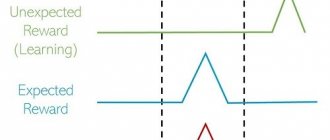External and internal motivation – where to look for the need for development?
Life goes, but where? A person goes through life in a certain direction, and this direction is different from ordinary survival. There is an animal in everyone, driven by instinct. There are motor muscles, a nervous system that provides movement. Motivation helps to make a person’s actions meaningful, and to make him humanized and intelligent, interacting with his own kind.
This is movement from point A to B with a specific goal. Point B may be desirable because it is prestigious. You need to get to point B according to your inner command - “I can!” One point - two motives. Therefore, we should talk about the types of motivation and the sources of their occurrence.
What is motivation
Motivation is a way to quickly achieve a goal, based on a psychophysiological process that guides a person’s behavior, promotes his activity and performance. It represents a set of motives.
According to V. Dahl's Explanatory Dictionary, motive in French means a motivating reason, a reason. To motivate means to give reasons that justify an action or prove the necessity of some action.
In simple words, motivation is a psychological push to a person that encourages him to achieve the goals set for him.
Main characteristics
The phenomenon of motivation can be described through the following characteristics:
- Directional vector.
- Organization, sequence of actions.
- Stability of selected goals.
- Assertiveness, activity.
Based on these parameters, the motivation of each individual is studied, which is important, for example, at school. These characteristics are also of great importance when choosing a profession. A sales manager, for example, must be consistently focused on high income and active in achieving the goal.
20.12.2019
4 453
Top 25 best motivating and inspiring films about overcoming yourself and life's difficulties
Write your top motivating films in the comments!
Types of motivation
To understand how motivation works, let's figure out what it is like.
Types of motivation are interconnected, often they complement each other and contribute to faster achievement of your goal.
Internal and external
Internal motivation is formed within the person himself.
What does it apply to:
- dream, desire for self-realization, creativity;
- self-affirmation;
- curiosity;
- conviction.
For example, you are interested in making something, you are happy to work in this direction and achieve your goal. A high result will be achieved due to the fact that you like your work, so you will perform it efficiently, strive to complete your work faster in order to see and evaluate the result of the work.
The key point in internal motivation is the feeling of freedom of choice. If you have to make not what you want, but what is necessary (for example, related to production duties), your motivation drops.
External motivation is factors that appear from outside. For example, circumstances in which you feel strong positive or negative emotions. The most striking example of external motivation is material reward for one’s work, if it does not evoke other positive emotions in the employee.
More examples of extrinsic motivation:
- career;
- prestigious things (car, house);
- opportunity to go on a trip.
External and internal motivation can act as a single incentive for work. Let's say you want to get a promotion. On the one hand, your need is related to internal motivation, and on the other hand, you also have external motivation - dissatisfaction with your social position. You develop an intransigence that you are being commanded by a less professional person (in your opinion) who is limiting your freedom.
Positive and negative
Positive, when a person receives a charge of positive emotions that help him move further towards achieving his goal.
Examples of positive motivation:
- praise, public recognition of merit;
- financial incentives;
- pleasant conversations.
Negative motivation is the avoidance of negative experiences. It can also be an incentive to speed up work. However, this only occurs in the case of strong short-term stressors. For example, issuing a reprimand for untimely completed work. May result in the employee no longer missing deadlines. However, with prolonged and regular negative influence, a person will feel depressed, which can lead him, on the contrary, to depression.
Positive motivation works better than negative motivation. If you really want to achieve something, you will try to achieve your goal without fear of punishment.
Stable and unstable
Everyone has sustainable motivation. This is the satisfaction of one’s needs, for example, satisfying hunger, thirst, and physiological needs. Here motivation works flawlessly and does not depend on the psychological or emotional state of a person.
Unstable people need constant external support. For example, you want to lose weight. In addition to wanting to, you will need to set a specific goal for yourself - go on a diet, play sports, etc.
If we consider stable and unstable motivation, they can be divided into subtypes: when a person strives for a set goal (male) or tries to avoid something (female).
Other types
Additionally, motivation can be:
- Individual . It supports human self-regulation: avoiding pain, quenching thirst, maintaining temperature.
- Group . Motivation associated with building social connections: caring for offspring, maintaining the structure of society.
- Cognitive . This is our research behavior, the desire to learn new things.
Extrinsic versus intrinsic motivation: which is stronger?
One side of motivation supports the other. Praise, gratitude or feedback from a client evokes a sense of professionalism and competence, which increases internal motivation. Then, for the sake of approval from outside, you want to increase your skills, efficiency, and develop as a person. Falling in love with work and being inspired by the activity appears.
The relationship between internal and external is shown in the types of motivation that express the desire for success, popularity, recognition of significance, overcoming and self-overcoming (improvement), and vocation. These types are presented in the form of a ladder of human self-development. They show how a focus on external success creates people who are satisfied with their work.
Motivation levels
Motivation has different levels. One flows from the other, from lower to upper, and they are all interconnected and form a pyramid, at the top of which the goal is located.
For example, you are motivated to discuss a project with a colleague in order to better understand the task at hand. You need this to cope with the difficulties that arise, because you are interested in a high-quality result of the work.
The most important levels of motivation are motivation for the task and for the project.
Maslow's Hierarchy Theory
How to find motivation? You need to have certain knowledge to answer this question. In order to bring together many ideas about innate needs, the American psychologist had to carry out a thorough analysis of a person’s character, its changes depending on a change in goal, and study the types of motivation. The main provisions of this concept are:
- a person always has a need for something, it does not depend on gender and age;
- strongly expressed needs that an individual experiences in certain situations can be combined into groups;
- the arrangement of these groups is built on a hierarchical principle;
- a person takes actions due to unmet needs;
- after some time, the person becomes dissatisfied again, he wants to get more;
- in a normal state, an individual feels several needs, they can be interconnected;
- first, the desires at the base of Maslow’s pyramid are satisfied, then the upper needs begin to influence;
- a person is able to find a greater number of ways to satisfy high needs than low ones.
Later, American psychologist Abraham Maslow added several more important components of the pyramid. In his work “Toward the Psychology of Being,” the author identified growth needs that turned out to be difficult to describe. This book includes such interesting qualities as perfection, the desire to be above others, justice, responsibility, beauty, friendliness, completeness. The author described in detail the forms of motivation.
Maslow believes that in many cases, growth needs are the most powerful motivator for achieving goals. Each person can check the authenticity of these words for himself. It is enough to write down the most significant needs, arrange them according to a hierarchical principle: at the bottom is what is satisfied first, at the top is what you have to work hard for.
According to Maslow, only 2% of the population reaches the stage of self-realization, while others are forced to constantly strive for perfection. For many people, motivation to act appears only in critical situations.
Motivation for the project
The project level is higher. It allows you to work with pleasure even on uninteresting tasks for the successful completion of the project. Motivation for a project is associated with feedback, which shows how close the goal is. Thus, even an uninteresting task becomes a positive experience. If the manager does not pay attention to the fact that the completed task brought him closer to the completion of the project, the employee feels that he is simply being exploited, because he does not see the result of his work. Even if he enjoys his own performance, he will have a feeling of routine. Therefore, project motivation in the form of feedback is especially important in large teams in order for employees to successfully cope with assigned tasks.
The history of the word and its special approach
In ancient times, the word “motivation” was not used in Russian speech. Most often in communication, people tried to explain the incomprehensible state that prompted them to perform a particular task. This could be a desire to carry out an important and dangerous task that would benefit the family and people, or it could even incite them to criminal activity.
What is motivation, how does it affect a person’s life? The concept of “motivation” comes from the Latin word “movere”, which can literally be translated as movement, awakening. They began to actively use it to convey their own moods only at the beginning of the 18th century. Oddly enough, noble people used this concept exclusively in the stable phrase “to motivate oneself,” that is, to encourage oneself to act. It is worth noting that motivation is a function of management, which is quite popular in the West. It is used for networking and management.
Motivation - what is it? In the modern world, people quite often pronounce the concept of “motivation”, without fully realizing the true interpretation of the word. What is the concept of motive and motivation? There are currently several definitions:
- motivation is a person’s conscious attraction to fulfill a certain goal, which can be compensated by both material and spiritual values;
- motivation is a manifestation of human desire to achieve a given task, manifested in changes in internal and external states;
- motivation is a definition that affects the spiritual aspects of a person’s state, his ability to set high goals for himself;
- achievement motivation - the desire to achieve the best result, the desire to look for new goals and objectives;
- motivation - the ability and desire to satisfy material, biological and spiritual needs;
- motivation is the desire to achieve a result, a psychophysiological process that controls human behavior, emotions, and actions.
It becomes clear that motivation is a complex and highly individual concept. The desire to achieve success appears in a person in different situations, and, accordingly, the ways to achieve the result will differ. Basic elements of motivation: goals, objectives, policies, methods, tools, programs.
The best minds around the world have been studying motivation in detail. We can highlight the works of V.G. Podmarkova, I.F. Belyaeva, D.S. McClelland, J. Atkinson. Most psychologists and philosophers reflected the collected information in theories and ideas that even now help a person rethink life. The functions of motivation, as a rule, are aimed at achieving the assigned tasks. They give the entire system integrity and stability.
Popular theories of motivation
The direction of studying the theory of motivation is popular in psychology. Scientists in different centuries have been engaged in putting forward and proving theories. Modern psychology also applies teachings in our lives and activities. After studying the basic concepts, it is easier to understand the types of personal motivation and analyze human behavior in different life situations.
In the field of theories, there are 2 main directions: procedural and substantive.
Maslow's Hierarchy Theory
Assumes that human needs are formed into groups that are united according to a strict hierarchy. Such a theory is depicted in the form of a pyramid, where at the base are the basic needs of the body (sleep, food, rest), at the top is the achievement of maximum development of the individual, the full disclosure of its natural potential, inclinations and abilities.
Alderfer's ERG theory
Yale University psychologist K. Alderfer identifies 3 groups of motivation:
- existence;
- communications;
- height.
These include any needs of the human body. Unlike Maslow, he recognizes the possibility of movement from lower to higher levels in different ways. The psychologist believes that dissatisfaction with the needs of the higher level leads to dissatisfaction with the needs of the lower level. As a result, a person's attention switches to lower-level needs.
For example, a person did not satisfy his need for personal growth, so his needs for connection (self-affirmation) became more active. This is a regression from a higher stage to a lower one.
Vroom's expectancy theory
Canadian psychologist V. Vroom developed a theory based on three types of connections:
- Cost-benefit . The result of the work must justify the efforts made.
- The result is a reward . The higher the result, the greater the reward should be.
- Reward-satisfaction . How satisfied the person is with the reward.
According to Vroom's expectancy theory, active need alone is not enough for effective work. It is not enough to just have a desire and do nothing; you need to try to fulfill it.
An example of a theory from practice: increasing sales and revenue is the main task of trade workers. The motivator for sales growth is decent wages.
Edwin Locke's Goal Setting Theory
American psychologist Edwin Locke developed the theory of goal setting in 1968. It explains how a person will act in specific work situations. According to his theory, motivation to achieve goals will be determined by the goals themselves or the simple fact of their proposal.
A goal is something a person strives for. Desire is the main source of motivation. People create their own goals, then achieve them. According to Locke, the best goal is an accessible, realistic, possible goal.
Adams' theory of equality (justice)
Equity theory was developed in 1960-1962 by American psychologist John Stacy Adams, after conducting research in. It explains why companies are experiencing declining performance.
According to the psychologist, this depends on how motivated the employees are to work. Many people think they are being treated unfairly and lower their wages. Others, on the contrary, consider themselves overrated and feel guilty. Labor productivity will fall until employees understand that the amount of remuneration directly depends on the efforts they put in. And if someone receives a large salary, it means that they have invested more effort and resources.
Porter-Lawler model
The Porter-Lawler theory is called the theory of justice and truth. This model helps the employee understand that the result of work directly depends on his abilities. It is also important that the employee understands his high value to the company. The psychologist argued that the more an employee puts in the effort, the more satisfaction he receives from the reward. Motivation is a way of inducing action.
The Porter-Lawler motivation model is classified as a process theory because it helps to determine the relationship between employee productivity and the system of remuneration and other incentives.
McClelland's theory
The theory is based on the study of the influence of needs on motivational processes in the consciousness of an individual. Motivation helps to unlock human potential, pushes us to take decisive action, and forces us to achieve success. The theory includes the need for power, success, and belonging to a certain segment of society. If you conditionally divide employees into these categories, it will be easy to find an approach to everyone.
David McClelland's theory of motivation is used in the process of organizing the work of employees to increase labor efficiency.
McGregor's Basic XY Theory
McGregor believed that there are two types of personnel management, one of them is based on “Theory X”, the other on “Theory Y”.
Theory X consists of the following postulates:
- people are lazy by nature, at the first opportunity they avoid work in every possible way;
- a person does not like to take responsibility; it is enough for him to work calmly and receive a salary;
- control, pressure and threats of punishment are inevitable; this forces a person to work more efficiently.
Theory Y statements:
- the person does not have an innate dislike for work;
- success brings pleasure;
- favorable working conditions contribute to the development of self-control and responsibility;
- people are able to solve problems creatively;
- achieving a specific goal is rewarded.
The combination of these theories makes it possible to appeal to different desires and motives, selecting methods of motivation for people of both categories.
Modern Z Ouchi Theory
Theory Z suggests that employees need to communicate with their employer and co-workers. This provides a high level of support from management in the form of creating a safe and comfortable working environment, and provides employees with the opportunity for development and training.
Employees expect reciprocity and support from management. It is important to maintain a balance between work and personal life. Therefore, not only working conditions are important, but also family, culture and traditions. According to Theory Z, employees have confidence that they can do their jobs correctly with proper support from management.
Theories based on a specific picture of a person
There are 2 concepts based on a specific picture of a person: “Theory X and Y” by McGregor and “Theory Z” by Ouchi. They describe the types of work motivation.
McGregor's XY theory
These are 2 theories in which the author compares the employee’s incentives and the behavior of the company’s management from 2 sides.
Theory X states that:
- people are naturally lazy and use every opportunity to procrastinate;
- a person seeks to escape responsibility, so he becomes an employee;
- he adheres to principles such as stability and security;
- sheds ambition as ballast;
- complete control, pressure and the threat of punishment push a person to work with greater efficiency.
According to Theory Y:
- work is an integral part of human life;
- good working conditions contribute to the development of responsibility and control over one’s actions;
- creative and intellectual potential is not fully used;
- Having achieved the goal, the person receives encouragement.
These are 2 diametrically opposed theories that have the right to life.
Ouchi's Z Theory
In addition to the previous 2 theories, American professor William Ouchi developed Theory Z. It is based on collective principles of motivation, according to which the incentives of employees should be influenced by the company’s values:
- coincidence of the goals of the employee and the enterprise;
- proper organization of work;
- dedication to the team and common goals;
- solidarity;
- confidence.
Positive aspects of this theory:
- The vector of attention is aimed at motivating all employees.
- The presence of managers in the company, their positive communication with subordinates.
- Organization of on-the-job training.
- Providing growth opportunities.
Disadvantages of the theory:
- Excessive requirements for applicants.
- Compliance with established principles, patriarchy.
- Slow promotion.
Popular motives
There is no single motive for stimulating the entire team or a specific person. Even in the same case, everyone's motivation may be different.
Let's consider the most effective motives:
- Self-affirmation . The desire to establish oneself in society. This motive is typical for proud people who strive to be recognized in society, to achieve high status and recognition.
- Identification . The desire to be like another person, for example, an idol, a hero, a father. The motive contributes to the emergence of a desire for improvement and development. This type of motivation works well for teenagers and provides a good incentive to learn new things. For example, a child wants to be as smart and strong as dad.
- Power . The desire to gain the opportunity to influence people, to take a leading position in a team or another group. This is one of the main motives for taking progressive actions, despite the difficulties and efforts made.
- Procedural-substantive motives . When a person likes the work he does. For example, when playing sports, a person enjoys showing his physical fitness. He is satisfied by the process of the game, and not by external factors (such as victory, money, power, self-affirmation, etc.).
- External motives . This is when a person performs work from which he himself does not receive satisfaction, but he expects a good reward. For example, a person quits a job that brings him satisfaction due to low income. To provide for his family, he decides to engage in routine (in his opinion) activity, but one that brings good income.
- Self-development . The desire to realize one's own capabilities. Fundamental motive for achieving results. To move forward, you need to have the courage to leave the past, not to hold on to past achievements. Don't be afraid of possible risks and failures. With each new step a person will receive more satisfaction and joy.
- Achievement . Achieve high performance results. A motive that encourages young people to achieve maximum results, even if it is necessary to make efforts. As an example, consider two students with the same ability to learn science, but with different motivations. The first one has set a high goal for himself and is trying to achieve it by choosing non-standard ways to solve problems. The second is indifferent to his successes and does not set high goals. It is clear who will achieve more success in life.
- Affiliation . This is the intrinsic value of communication when a person tries to maintain relationships with other people and he likes it. Communication brings him satisfaction, he strives to please the interlocutor and thereby improves himself.
- Prosocial motives . They are associated with an awareness of duty to society and responsibility to people. A person needs to live by the problems and interests of a group of people. Responsible people do their work more conscientiously. They are active and believe that the success of the entire company depends on the quality of their work.
Self-motivation
Self-motivation is the use of individual motivational methods based on personal beliefs:
- desires and aspirations;
- focus and consistency;
- determination to act and consistency.
The main indicator of correct self-motivation is the situation when, in the presence of great interference from the outside, a person does not give up and continues to move towards his goal.
The individual performs conscious actions aimed at achieving the desired result.
To motivate yourself, you can use methods such as:
- affirmations - a selection of positive statements that influence the individual’s subconscious and lead to a positive effect;
- self-hypnosis is an influence that has a person’s independent influence on his own psyche, the purpose of which is to create a new behavioral model;
- biographies of successful people are an effective way of stimulation based on studying the life stories of great personalities;
- formation of strong-willed skills - performing actions aimed at overcoming one’s own laziness, fears and reluctance to act;
- Visualization is an effective method that is based on the mental representation and emotional experience of achieved goals.
Self-hypnosis
Self-hypnosis can be effective only if a person has the ability to do so: he can influence his subconscious and psyche, causing the desired reaction and achieving a positive effect.
Biographies of successful people
Using this method is suitable for both children and adults. A person sees the full picture: there was a desire, then action followed, and then the result.
Visualization
Visualization is a powerful method of achieving goals, because thoughts tend to materialize. An important condition for its use is the presence of active actions to achieve goals.
Advice from psychologists
- Start small . Set a goal that you can achieve in the near future. If you want to lose weight, start getting up early to exercise.
- Set only one goal . It’s difficult to achieve several goals; it’s better to complete one first, then take on the next one. After you regularly start doing exercises, stop eating after 18-00.
- Make public promises . If you communicate your intention to others, it will be harder for you to give up on your plan. Tell your loved ones about your intention to lose weight.
- Look forward to achieving your goal . Think about how good it will be for you. Take out your favorite outfit that has become too small for you and hang it up so you can see it more often.
Definition
What is motivation? To have at least the slightest idea about such a concept as motivation, let’s look at its definition. In Latin, "muvere" (to move) defines the word "motive", which is a derivative of the word "motivation".
Thus, we can give several options for the concept of this word:
- encouragement to action;
- a psychophysiological process that controls human behavior, setting its direction, organization, activity and stability.
- a set of motivating factors that determine human activity.
Experts disagree on what motivation is. Some believe that it is a set of processes, while for others, a set of motives determines motivation. The motive is a material object, the desire for which determines the meaning of actions. For people, this is expressed in anxiety or worries, which in the future can cause both positive (in case of achieving the object) and negative (in case of dissatisfaction with the situation) emotions.
An example would be a desire caused by hunger. A person strives to get food in order to satisfy his desire. Positive emotions are caused by the fact that the goal is close, and negative emotions - if such an opportunity is not foreseen in the near future, in this case dissatisfaction appears.
How to stay motivated
If you have given up, it is difficult for you to follow the chosen path, do not be sad, listen to the following advice:
- Stop . Give yourself a little break, relax, even if you think that you have a lot of strength and are ready to work hard. There is a risk of burning out.
- Just start . Start achieving a new goal slowly, regularly moving forward in small steps.
- Get rid of negativity . Don't let yourself think that you won't succeed.
- Learn to think positively . Believe that everything will work out for you.
Developmental exercises for children and adults
Where to get motivation? These interesting complexes will help set a goal and motivate a person to complete the assigned tasks:
The first is identification with your favorite animal. By associating himself with a fictional character or a very real object, an individual can quickly achieve personal growth. The fact is that a person subconsciously takes on the positive qualities of his favorite hero, and at the same time new goals appear. Animals are strong and wise creatures that are a major part of the world around us. By identifying with them, the individual cultivates caution, perseverance, and determination.
So, to complete the exercise you need to do the following:
- choose one favorite animal, describe its positive and negative qualities;
- try to imagine yourself as an imaginary creature, try to go towards your goal;
- feel like a formidable lion or a cute rabbit for 5 minutes, try to overcome all the difficulties that the animal encounters on its way.
After this, you should evaluate your feelings and experiences, analyze which tasks were achieved and which were too difficult.
Complex two is to point out the mistake and note the improvement. What to do if you lose motivation, how to get it back? It is worth giving an example from life. Often, kindergarten teachers and school teachers make comments to children about performing various tasks. They point out errors in completing the test, and then analyze complex tasks. Why is this being done? This is how the older generation motivates children to perform the same tasks, but with a higher quality.
The motivation exercise should be performed several times a week. To begin with, it’s worth imagining a situation where a person is one step away from his goal. He should describe the pros and cons of this provision. As a rule, there are always more disadvantages than positive features. But this is not a reason to be upset, because the next attempt will be better than the previous one:
- there will be many mistakes, but they will not be so serious;
- There will be many difficulties along the way, but what is important is what a person has already managed to achieve;
- let not everything go smoothly and according to plan, but this is not a reason to give up, because the hardest part is already behind us.
How to motivate staff
Proper employee motivation is of no small importance for a successful business.
The following methods are used for this:
- Economic ones are the most effective. This includes salary increases, bonuses, other incentive payments, and gifts.
- Organizational and administrative methods . These are not material payments, but they give employees privileges when working in the company. For example, providing free training opportunities, arranging production facilities, preferential medical care for staff, and creating a corporate identity for the company.
- Social-psychological methods . This includes methods such as recognition of authority, trust, support and strengthening loyalty, holding corporate events for a friendly and working atmosphere.
Modern Z Ouchi Theory
The concept of motivation differs in many cultures. Japanese experiments in the field of psychology and medicine prompted the brilliant American psychologist William Ouchi to create his own model Z. It is based on the principle of collectivism, when a person is presented not as a separate element, but as an important part of the entire mechanism. And if he refuses his work, then the whole device will immediately collapse.
To use Theory Z, you need to understand that most employees like to work in a team rather than handle a difficult task alone. In addition, employees are firmly confident that the employer will take care of them, and they, in turn, will do a high-quality job. Model Z will actively develop if the company meets the wishes of employees. The manager must give employees the opportunity to improve their skills and get promoted up the career ladder.
Mutual understanding and mutual commitment are the main principles of motivation, the key to a successful business and an excellent tool for stimulating employees. Employees interested in increased pay, receiving awards and badges, bonuses and changing positions will strengthen the company’s position and promote it to a leading position.
Applicable in this case are motivation methods that affect staff, students and the person himself. In all cases, it is necessary to focus on material incentives and compliance with moral standards. For example, students receive a scholarship for successful studies, and staff receive a scholarship for quality work completed on time. However, with self-motivation the situation is a little more complicated. It is always difficult to start, namely to find a reason for which all efforts will be made. Nevertheless, it is one’s own desire that can radically change not only life, but also the person himself.
Student motivation
To motivate your child to learn, use the following methods:
- Encouragement. Celebrate class work, demonstrate excellence, and convey positive feedback about children to their parents.
- Create unusual situations in the classroom. Children will become interested.
- Infect your students with your emotions. Show your enthusiasm and help students connect with it.
- Give every student the opportunity to express themselves.
These tips apply not only to teachers, but also to parents.
Daily trainings for yourself and family
You can motivate yourself to complete tasks in a circle of close people, ask for advice and find out what other people think about you. Such methods of motivation help you look at yourself from the other side, see what is being done wrong, where a mistake is being made:
- Braggart. Where to find motivation, how to develop it? This complex will help you change your ideas about your own life. The exercise is aimed at developing the inner world and unlocking creative potential. A person needs to imagine himself as the head of a well-known company; the boss has professional employees at his disposal. For the first time, a manager must reproach his employees, show his advantage, and deprive employees of a well-deserved bonus. In the second case, the boss should treat his team favorably. Listen to their requests, ideas, reward the best employees of the company. Thus, a person clearly sees that much depends on himself. The result of actions directly depends on a person’s attitude towards the process itself. A clear understanding of goals and ways to achieve them is the key to success and self-realization.
- Analysis of justifications. How often does a person find a seemingly logical explanation for a situation, but at the same time say nothing about the mistakes made? The goal of this exercise is to understand that everything depends only on your own strengths, and not on imaginary problems. The exercise works as a motivation mechanism; it allows you to find the missing detail or missed action in time. Most of the reasons for failure are related to wrong thinking, choosing the wrong path. It is the person’s own fault that he failed to achieve what he wanted. But this is not a reason to give up all ideas and go into depression, this is just a starting point for new achievements. When an individual begins to look for external reasons for failure, then he blocks his true motives and desires. A search for other reasons may indicate that a person:
- does not know how to organize and control himself;
- does not know how to set priorities correctly;
- does not know how to systematically perform work.
To complete the exercise, you should take a blank piece of paper and write a sentence, for example: “I did not complete this task because...”. It is necessary to analyze the justification and answer the questions:
- Why was this particular justification chosen, is there an alternative to this?
- Does it depend on external and internal factors?
- What is preventing this situation from being corrected?
At this stage, you should consider what measures can be taken to achieve the goal. The main motivation tools: money, health, connections.
How to spot a motivated person
A motivated person is collected, he clearly understands what he wants and how it can be achieved.
Signs of motivation:
- Showing initiative.
- Activity. An attempt to influence the quick completion of the case.
- He acts on his own, rather than waiting for someone else to do it for him.
- The man loves his job.
- Confidence. He is proud of the responsibility he has taken on.
In psychology
Psychologists consider the process of motivation in the following areas:
- Behaviorism, when a need arises if the body deviates from a certain ideal norm.
- Psychoanalysis, when the motive is formed by unconscious impulses.
- Cognitive theory, when a person is motivated by his view of the world.
- Humanistic theory as the realization of one’s own needs, plans and ideas.
In management
In personnel management, the sign of motivation means the desire of people to work for the benefit of the enterprise.
Theories of motivation are divided into substantive - the study of human needs and motivating actions, and procedural - the study of factors that influence the degree of motivation.
In economics
From an economic point of view, in production it is necessary to create not only material incentives, but also intangible ones: social guarantees, a comfortable environment, a trusting atmosphere.
Why is it needed?
Motivation is a complex psychological phenomenon that performs an important function. Namely, it prevents a person from dying on the couch and turning into a vegetable. It promotes development, helps to rise after falls, strive and achieve, see the goal and move towards it through obstacles. Well, if this is not the case, figure out how to find a purpose in life when you don’t want anything.
Action under the influence of motive is very necessary for every person. Without motivation, there will be no organization in our life, we will not be able to organize our affairs, we will be scattered about various small matters and in the end, when we get tired of everything, we will fall limply on the sofa and that’s it.
Common myths about motivation
In addition to actually working methods of motivation, you can also come across various theories that do not always work:
- Money is the main motivator . This doesn't work for everyone.
- Make every effort to achieve your goal . This way you can quickly burn out without achieving your goal.
- Visualize success . Visualization is a useless tool unless it is backed up with action.
- Fear is a good motivator . This may be good for short-term results. In the long run, negative motivation is definitely a bad choice.
- Write down your goals . Simply setting goals does not give the desired effect.
Motives of human desire for change
How to motivate people and yourself? Some people want to climb the career ladder and achieve high results in their professional activities, while others want to find a soul mate and create a cozy nest. The classification of motivation methods by general theme, attribute and type made it possible to identify key points that influence the formation of goals. The main motives that motivate a person to perform certain actions:
- self-affirmation;
- identification;
- power;
- procedural and content motives;
- self-development;
- achievements;
- affiliation.
Each motive plays an important role and influences the entire cognitive process. Sooner or later, a person receives a real picture, which until that time he could only store in his own imagination. But what are the theories and concepts of motivation? What do famous psychologists and philosophers think about this?
There are 3 main theories that determine what level a person is at. These are substantive, procedural, specific theories.
The content base is based on human needs. They allow you to assess the state of an individual, consider the principle of his work, and follow the train of thought. In such a theory, a special emphasis is placed directly on studying the structure of human desire, its possibilities and future prospects. The task is to understand what exactly caused motivation in a person and how this process functions. Excellent works on this topic have been published by the greatest minds of all centuries. This is the famous theory of Maslow's hierarchy of needs and McClelland's theory of acquired needs, Alderfer's reasoning and forms of motivation, Herzberg's thoughts on two factors.
Process theories are primarily concerned with the analysis of the efforts that were made by a person. The feelings that a person feels in a specific situation or when performing a task are considered. Today, there are more than 50 interesting theories, including the reasoning and conclusions of Vroom, Adams, Porter-Walter, Locke.
Specific concepts are associated with a person’s perception of the outside world, the ability to feel and sympathize. The basis is the model of an employee who has a unique set of motives, needs, and emotions.
FAQ
Is one type of incentive enough to stimulate team work?
It depends on the size of the goal. If it's a small project, that's enough. For large companies, psychologists advise using at least 4 methods, and preferably at least 16.
What does motivation management mean?
In any team, there is a periodic decline in motivation and, as a result, the efficiency of workers’ work decreases. Management who knows how to manage motivation will be able to quickly switch to other methods and apply additional methods to motivate employees.
What role does gamification play in motivation?
Gamification is an innovative way to motivate employees. The opportunity to complete various quests, competitions, and compile rating tables develops in employees a healthy passion for becoming the best, winning, and receiving a well-deserved reward.
Edwin Locke's Goal Setting Theory
The key question of the theory is: what are the goals of motivation, what motivates you to set them? The author of quite interesting works about human actions and the motives for these actions is the American psychologist and philosopher Edwin Locke. Hours of persistent research led the scientist to some very interesting thoughts. The psychologist carefully studied the forms and methods of motivation that had previously been written by his predecessors. Collected information about the effects of external conditions on the target.
What are the stages of motivation? How does a person set a goal? It was to these questions that the psychologist looked for intelligible answers, and ultimately created the theory of goal setting. The main idea is that a person’s behavior depends on the tasks that he has set for himself. It is common for an individual to experience emotional ups and downs. Any change in mood will certainly affect his goals.
Motivation and motives for actions taken depend on each other. The task plan chosen by a person should always lead him to a pleasant result. Using E. Locke's concept, a leader can raise the level of activity in the team. It is enough to know a few basic principles. The most important thing is to set a clear and achievable goal. You shouldn’t come up with something unimaginably complex and try to somehow bring it to life. At the same time, employees will have to work hard to achieve results. As a rule, in tasks of medium and high complexity, people strive to show all their abilities and perhaps reveal hidden potential. An additional advantage in this situation is the opportunity to bring people together in a team; a common goal allows you to forget differences and begin to act as a cohesive team.
Employees should be aware of all successes and progress in the common cause. Unreasonable secrecy and dissatisfaction with work can cause a huge collapse. At the same time, it is welcome if employees begin to actively share and implement their ideas. In most cases, it is precisely such thoughts that contribute to improving the quality of work, since favorable conditions appear. Who, if not the worker, knows what he needs for successful professional activity? Maybe you need to buy new equipment for the plant or make repairs in the office? In this case, an important role is played by the increase in motivation, which occurs due to the mutual understanding of colleagues.
If the goals of employees and management differ, then a common agreement should be reached. The main task of a leader is to hear people’s indignations and, if possible, resolve disputes and disagreements. At the same time, the boss should reward the employee for quality work. This can be either material means or ordinary praise. The main thing is to understand in what situation to use positive sanctions towards an employee.
Consolidating results and maintaining motivation
There are 6 main ways to achieve what you want. Each of them is unique in its own way and is used in connection with specific conditions. The most important principle of any motivation is to do what you like and benefit. Only such things allow you to gain satisfaction; they are supported by an internal desire, the desire to accomplish the task in any way. These are the recommendations:
- Focus on the end result. Any task requires a special approach and considerable effort. Instead of focusing on the difficulties, you should remember the reason for which you will go all the way.
- Think only about victory. You should start by doing easy tasks and then enjoy the results. This, firstly, will cheer you up and help you gain confidence, and secondly, it will fill a person with energy to perform further actions.
- Do any difficult task. After you have successfully completed several easy tasks, you should take yourself to a more difficult task. If you postpone a difficult mission until the end of the day, it will smoothly move on to the next day, week, month. Thus, a difficult task will become almost impossible.
- Take regular breaks. When a person has rested and feels a new surge of strength, it is much easier for him to start performing any task. Instead of spending hours doing tedious work, you should relax and get some rest. This will bring you organization and help you do what you love without being distracted by extraneous things.
- Don't burden yourself with unnecessary troubles. Many people are often overwhelmed with goals and tasks, they want to achieve a lot quickly, but in the end they get nothing. The desire to be the smartest, most beautiful, the strongest is, of course, good, but you shouldn’t set such global goals for yourself. You should concentrate on one specific task.
- Reward yourself for success. Often there is achievement motivation that needs to be stimulated independently. Small prizes for each correctly taken step encourage a person to continue to work efficiently.
How to increase motivation? Everything depends on the person and his desire, it must come directly from the soul. Human motivation is, first of all, perseverance, patience, the ability to work, the ability to understand one’s needs, and the ability to control the situation. Only those people who have good motivation are able to realize themselves in life.










